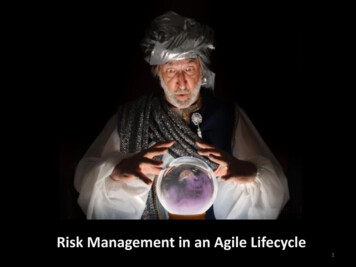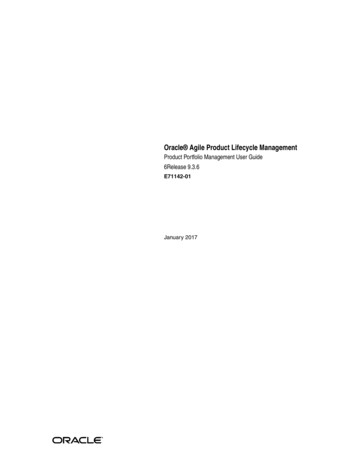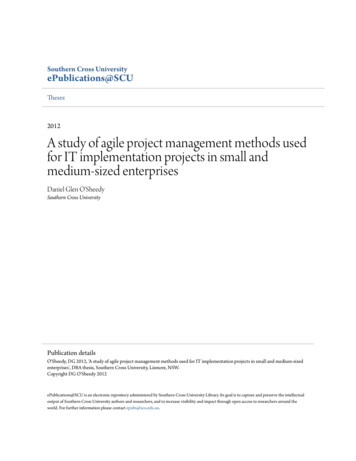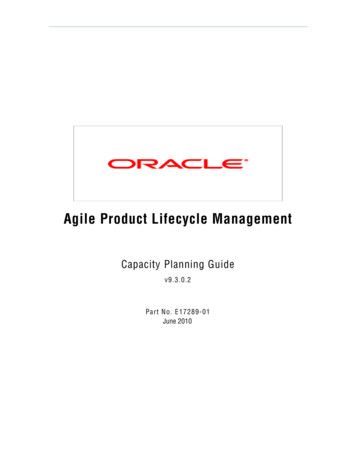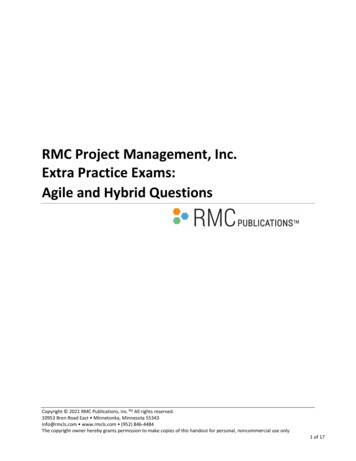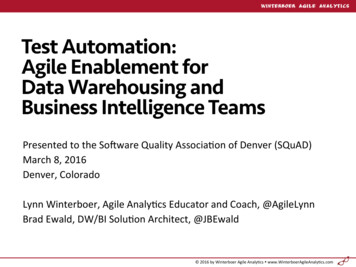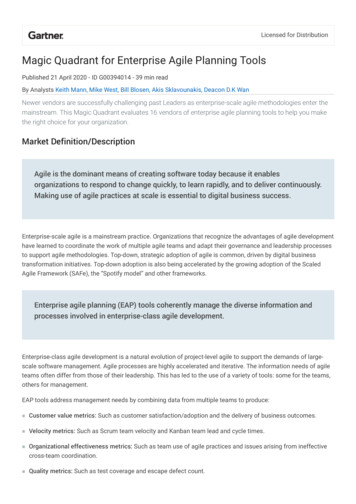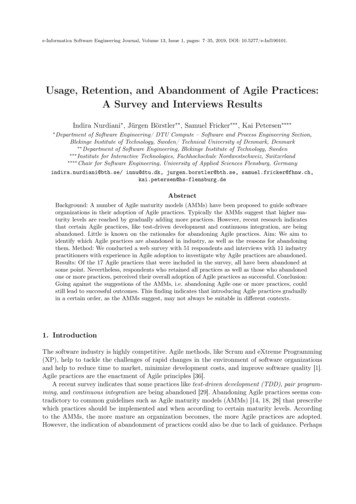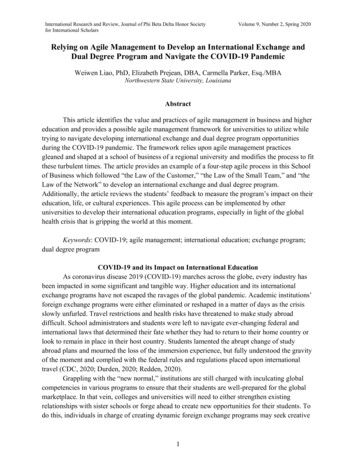
Transcription
International Research and Review, Journal of Phi Beta Delta Honor Societyfor International ScholarsVolume 9, Number 2, Spring 2020Relying on Agile Management to Develop an International Exchange andDual Degree Program and Navigate the COVID-19 PandemicWeiwen Liao, PhD, Elizabeth Prejean, DBA, Carmella Parker, Esq./MBANorthwestern State University, LouisianaAbstractThis article identifies the value and practices of agile management in business and highereducation and provides a possible agile management framework for universities to utilize whiletrying to navigate developing international exchange and dual degree program opportunitiesduring the COVID-19 pandemic. The framework relies upon agile management practicesgleaned and shaped at a school of business of a regional university and modifies the process to fitthese turbulent times. The article provides an example of a four-step agile process in this Schoolof Business which followed “the Law of the Customer,” “the Law of the Small Team,” and “theLaw of the Network” to develop an international exchange and dual degree program.Additionally, the article reviews the students’ feedback to measure the program’s impact on theireducation, life, or cultural experiences. This agile process can be implemented by otheruniversities to develop their international education programs, especially in light of the globalhealth crisis that is gripping the world at this moment.Keywords: COVID-19; agile management; international education; exchange program;dual degree programCOVID-19 and its Impact on International EducationAs coronavirus disease 2019 (COVID-19) marches across the globe, every industry hasbeen impacted in some significant and tangible way. Higher education and its internationalexchange programs have not escaped the ravages of the global pandemic. Academic institutions’foreign exchange programs were either eliminated or reshaped in a matter of days as the crisisslowly unfurled. Travel restrictions and health risks have threatened to make study abroaddifficult. School administrators and students were left to navigate ever-changing federal andinternational laws that determined their fate whether they had to return to their home country orlook to remain in place in their host country. Students lamented the abrupt change of studyabroad plans and mourned the loss of the immersion experience, but fully understood the gravityof the moment and complied with the federal rules and regulations placed upon internationaltravel (CDC, 2020; Durden, 2020; Redden, 2020).Grappling with the “new normal,” institutions are still charged with inculcating globalcompetencies in various programs to ensure that their students are well-prepared for the globalmarketplace. In that vein, colleges and universities will need to either strengthen existingrelationships with sister schools or forge ahead to create new opportunities for their students. Todo this, individuals in charge of creating dynamic foreign exchange programs may seek creative1
Relying on Agile ManagementLiao, Prejean, & Parkeralternatives to traditional ones. This is critical because international education remainsimportant to provide global contexts in learning experiences under the guidelines of theAssociation to Advance Collegiate Schools of Business (AACSB International) Standard13.For any teaching and learning model employed, the schoolprovides a portfolio of experiential learning opportunities for businessstudents, through either formal coursework or extracurricular activities,which allow them to engage with faculty and active business leaders.These experiential learning activities provide exposure to business andmanagement in both local and global contexts (AACSB International,2018, p.40).Also, these standards mandate which educators supply documentation ofengagement, innovation, and impact in business programs. At a regional universityunderpinning our dynamic curriculum is our commitment to AACSB InternationalStandards through our Assurance of Learning Goals. We have four goals that all ourmajors should be able to do once they graduate. The four goals are:Goal 1: Effective CommunicatorsGoal 2: Integration of Knowledge across Business DisciplinesGoal 3: Critical ThinkingGoal 4: Global, Cultural and Ethical Perspective.Specifically, our students for Goal 4 should be able to identify global, cultural,and ethical challenges facing management in doing business in the international arena.How can we carry out this goal in northwest Louisiana? We, of course,accomplish this through assignments, such as multi-cultural projects, simulations, andexperiential learning projects, etc. (Liao et al., 2019), but we also, through agilemanagement, work to allow our students to attend schools around the world.Agile management relates to the quick response between business, industry, andeducation to the many challenges and changes daily in the corporate climate. Agile, bythe face meaning of this word, is the ability to create and respond to change (Prejean,Kilcoyne, Liao & Parker, 2019). It is a way of dealing with and succeeding in, anuncertain and turbulent environment (Agile Alliance, n.d.). According to ProjectManagement Institute (2017), agile can be “an approach, a method, a practice, atechnique, or a framework” depending on the situation where it is used. According toDenning (2018), organizations that have embraced agile have three core characteristics:the law of the customer, the small team, and the network.The School of Business uses this agile process for the development of itsinternational exchange and dual degree programs. One recent example of the utilizationof this agile process was to increase our visibility in China. We decided that our studentsshould explore China and allow students from China to learn about the United States viaour school. We did so because this exchange would enhance our classroom discussions2
Relying on Agile ManagementLiao, Prejean, & Parkerand provide tools for both the U.S. and Chinese students to identify issues in the internationalbusiness arena. As such, our article will explain how agile management guided our mission ofdeveloping a Memorandum of Understanding (MOU) between our university, and a prominentuniversity in Shenzhen, Guangdong Province, China, to provide exchange and a dual degreeprogram for these types of learning opportunities. In our article, we will define agilemanagement, relate agile management to our process, explain our course matching process, andshare the outcomes of our implemented MOU. Additionally, we will share possiblemodifications to this process that may be made to cope with the coronavirus pandemic tocontinue the work of educating our students internationally. We hope that after one reads thisarticle other universities that have not yet developed international higher education partners mayimplement a similar agile process. In doing so, other universities can, despite the global healthcrisis, stretch their students’ global business imaginations.Literature ReviewThe Characteristics of Agile ManagementTo begin, we decided that there should be a deep dive into the essence or characteristicsof agile management. According to Denning (2016a), in an agile organization, “self-organizingteams” are continuously providing new value for customers. Work is done in a repetitive formatwith continuous interaction from small team members working together using resources of theorganization to complete projects in short timelines which is essential in business today. It alsoallows teams to work autonomously and creatively increasing loyalty and efficiency in theorganization. The organizational structure of the team is different from the traditionalbureaucratic teams because the traditional organizational bureaucratic structure cannot respondto fast changes. All teams work to solve problems as quickly as possible, but the agile team cansolve immediate and long-term problems quickly. Also, agile management's primary process isdifferent from traditional management because it primarily focuses on delivering innovation andvalue to customers rather than making money for shareholders and top executives.According to Denning (2018), organizations that have embraced agile have three corecharacteristics:(1) The Law of the Small Team. Work should, in principle, be done in small,autonomous, cross-functional teams working in short cycles on small tasksand getting continuous feedback from the ultimate customer or end-user. Bigand complex problems are resolved by descaling them into tiny, manageablepieces.(2) The Law of the Customer. The very purpose of a firm is to deliver value tocustomers rather than to stockholders.(3) The Law of the Network. An agile organization is a fluid and transparentnetwork of players that are collaborating toward a common goal of delightingcustomers.3
Relying on Agile ManagementLiao, Prejean, & ParkerOf the three laws, the first enables the organization to solve problems and updatesolutions constantly rather than going through long processes to make changes. Thesecond law is the most important –it is the principle that makes sense of the other two andpermits the greatest insight into why an Agile organization operates the way it does. Yet,the lynchpin of agile management is really the third law (Denning, 2018), because thecustomer-focused small team cannot achieve optimal high-performance impact unlessand until the whole organization operates as an interactive network. It is when the threelaws combine and focus on a common external goal that we get the explosive incrementin value that comes from truly embracing Agile management.Agile for BusinessesThese three laws have been readily adopted by businesses. New agile processesallow businesses to flourish quickly and efficiently. The agile process increases teamproductivity and employee satisfaction while minimizing waste inherent in redundantmeetings, repetitive planning, and excessive documentation (Rigby et al., 2016). ForExample, Microsoft was able to decrease their production cycles from three years to threeweeks by adapting to the agile process. In the process, the physical workspace wasredesigned with open space, fresh vibrant colors, comfortable meeting rooms creatingopportunities to encourage collaboration in a pleasant and informal atmosphere (Denning,2015). Agile teams are more efficient giving more time for projects that are often omittedsuch as quality defects and low-value product features which increase revenue. Seniormanagers have more time to consider higher-value work such as creating and adjustingthe corporate vision; prioritizing strategic initiatives; simplifying and focusing work;assigning the right people to tasks; increasing cross-functional collaboration; andremoving impediments to progress with overall benefits to the teams and overallorganization (Rigby, Sutherland, and Takeuchi, 2016).Current businesses need to constantly change to adapt to the environment (Prejean,Liao, Aldredge, Parker, and Kilcoyne, 2020). Agile methodologies are spreading across awild range of industries. John Deere uses agile methodology to develop new machines.Saab used agile methodology to produce new fighter jets. Intronis, a leader in cloudbackup services, uses them in marketing. C.H. Robinson, a global third-party logisticsprovider, applies agile methodologies to human resources (Denning, 2016c). Mission BellWinery uses them for everything from wine production to warehousing to running itssenior leadership group (Rigby et al., 2016).During the COVID-19 pandemic of 2020, companies had to repurpose and adjustquickly and efficiently to survive. Notable organizations made agile adjustments tonavigate the COVID-19 pandemic include: LVMH Moët Hennessy – Louis Vuitton SE, also known as LVMH repurposedtheir factories to produce hand sanitizers (Newburger, 2020).4
Relying on Agile ManagementLiao, Prejean, & ParkerIn a matter of seven days, an impromptu Facebook group of some 300engineers and medical researchers banded together to design and produce anopen-source ventilator using 3D-printed materials and other easy-to-accessitems (Etherington, 2020). In several nations across the globe, ventilators arein short supply, as demand for the equipment grows in the wake of the spreadof COVID-19. The ventilator design will enter the validation process inIreland, potentially paving the way for adoption elsewhere. Meanwhile, thegroup, called the Open Source COVID19 Medical Supplies community, isturning its attention to designs for other badly needed medical equipment likemasks and sanitizers. One of the local breweries in Natchitoches Louisiana repurposed themselvesto create sanitizers to remain open and support the community (Cook, 2020).Management leaders who teach that teams with high satisfaction produce more and aremore effective in increasing the bottom line for business. Customers changing priorities are themost important part of competition today and having efficient methods of quick delivery is nolonger a choice, but crucial to ensure customer engagement and satisfaction. It often requires theengagement of team members from multiple disciplines as collaborative peers which buildsmutual trust and respect in the organization.Employees today are constantly training to keep up with the latest technology in all areasof business. For businesses to compete in the new world of technology and artificial intelligence,it will be necessary to streamline processes and change must be quick and valuable to thecustomer. Since the agile teams always need to deal with the uncertainties and complexity in thefast-changing environment and solve the recent problems which have not been done before, theteam members must develop and enhance new skills in real-time. Learning-by-doing is necessaryfor the employees in agile organizations (Prejean, et al., 2019). There are many assessment toolsincluding surveys, games, and checklists to determine what stage an organization or leadershipteam is currently in and the process of transformation into an agile system (Linders, n.d.). Agile in Higher EducationEven before the pandemic began, higher education institutions worldwide were makingchanges in the aspects of educational settings, instruction means, teaching methods, internationalexposures, and culture to be agile to satisfy the more customized learning demand of the students(Liao et al., 2019). They embraced agile to cope with complexity, uncertainty, and fast changesin the market.The United StatesHigher education embraced agile with diverse educational settings, means, and methods.These changes have revised the definition of higher education three times in the 21st century inthe years 2002, 2012, and 2017 in North American Industry Classification System (NAICS)under Code 611310 – “Colleges, Universities, and Professional Schools.” Instruction may be5
Relying on Agile ManagementLiao, Prejean, & Parkerprovided in diverse settings, such as the establishment's or client's training facilities,educational institutions, the workplace, or the home, and through diverse means, such ascorrespondence, television, the Internet, or other electronic and distance-learningmethods (United States Census Bureau, 2017). Classroom instruction also changed to amore agile method as a larger percentage of classes are offered online for theconvenience of working students. The emergence of Virtual Colleges/Universities(VCUs) in the United States is an evidence of the change (Prejean, et al., 2019). Beforethe COVID-19 pandemic, a number of international programs used online learning todeliver course content, connect students studying at different program sites and guide andassess student learning. The pandemic has made it necessary for institutions andorganizations to be even more creative in applying online learning for students who havereturned to the United States (Whalen, 2020). During the COVID-19 pandemic, whileinternational travels were banned or not applicable for study abroad tours, someuniversities were agile to apply the technology to give their students virtual internationalexperience. In switch the original study abroad program to a virtual tour with online jointclassrooms, virtual live cases and consulting projects, cultural online exchange with localstudents, and online talks with local companies. Table 1 gives an example of the studyabroad program, Global Business Immersion in Indiana University Kelly School ofBusiness (Dakhli & Kovacs, 2020) and how it was adapted to a virtual study abroadprogram in spring 2020. By applying the technology and designing activities to match theoriginal on-site study abroad program, they switched this program to a virtual studyabroad program in spring 2020 so students did not need leave U.S. to get the internationalexperience.Table 1Spring 2020 Global Business Immersion Program at Kelly School of BusinessOriginal Set upAdapted Set upMarch 9th – March 18thMarch 9th – March 18th3 credits3 credits16 classes on campus2 classes on campus 14 classes online4 company visits5 company online talksone case competition withlocal students from FEA-USPone case competition with 1 case competition with localstudents from FEA-USP, ESPM and UNIFESPcultural experiencescultural online exchange with local studentssightseeingno sightseeingNote. FEA-USP, ESPM and UNIFESP are three Brazilian universities.6
Relying on Agile ManagementLiao, Prejean, & ParkerEuropeThe mindset of agile in education leaders can be traced to the “Bologna Declaration”which was signed on June 19, 1999, by the European Ministers of Education (Prejean, et al.,2019). The Bologna Declaration recognized the highest importance to ensure “higher educationand research systems continuously adapt to changing needs, society's demands and advances inscientific knowledge” (European Ministers in charge of Higher Education, 1999, p.2). TheBologna Declaration triggered the creation of new administrative procedures, new concepts forthe description of curricula (Demartini, Enchev, Gapany, & Cudre-Maroux, 2013, p.5) andbrought institutional changes which challenged tradition. For example, in Finland, the reformsemphasized competitiveness, efficiency, and accountability which contested the Nordic welfarestate value of equality to build a more effective higher education system, integrate fragmentedhigher education and research activities, strengthen top-level and priority areas, and enhance theinternationalization of higher education (Ursin, 2019, p.67).AsiaUniversities in Asia are also becoming agile through providing students flexibility,experiential learning, and international exposure in degree programs and curriculums.Hong Kong University of Science and Technology (HKUST). In HKUST BusinessSchool, the undergraduate curriculum focuses on broad-based learning with a flexible structurewhere students acquire multidisciplinary skills relevant to the business environment. Over 80%of business students choose to specialize in two majors. Plus, they can also take non-businessminors to broadens their skills and knowledge to meet the employers’ expectations once theygraduate. They also have plenty of opportunities for international exposure (Study InternationalStaff, 2019).National University of Singapore (NUS). NUS Business School established anacademically rigorous yet flexible curriculum with a diversity of global and experientialopportunities. Students are taught to possess multiple skill sets and solve new business problems,so they can excel in a challenging and demanding workforce. The school also strongly focuseson leadership and entrepreneurial education (Study International Staff, 2019).SP Jain School of Global Management – Dubai. The school emphasizes real-worldbusiness skills alongside academic learning, ensuring that graduates are confident and hold therelevant expertise to compete in a global setting. Every business student is required to take up anAction Learning or Entrepreneu
Intronis, a leader in cloud backup services, uses them in marketing. C.H. Robinson, a global third-party logistics provider, applies agile methodologies to human resources (Denning, 2016c). Mission Bell Winery uses them for ever


